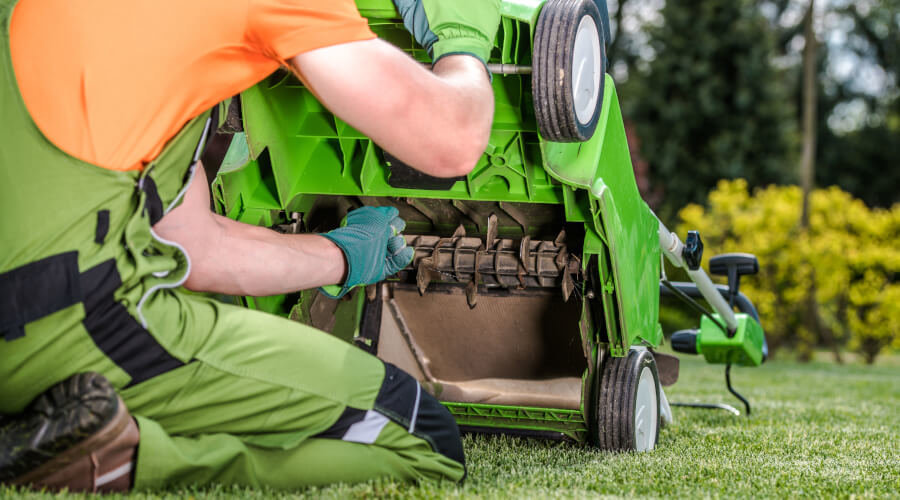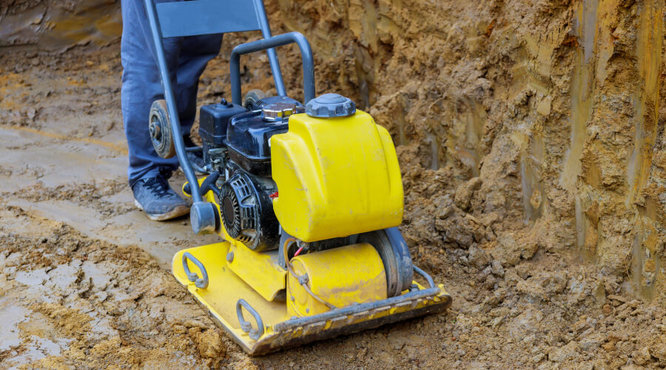How to aerate a lawn
Aerating your lawn is a key gardening practice for ensuring full, thick, rich and healthy grass growth. If your grass is patchy and yellowing and the soil is compacted, then aerating your lawn can help alleviate these issues and improve your lawn's health and appearance.
Lawn aeration is the process of making small holes in the soil, all over your lawn. You can do this in many ways, and these holes help relieve soil compaction, improve drainage, and allow vital air, nutrients, and water into the soil, therefore improving root growth and the overall health of the grass in your lawn.
Aerating a lawn: step-by-step
- Mow the grass. You should mow the grass a couple of days before you aerate the lawn. Aerators work much better when the grass is shorter, and core collection is much easier afterwards.
- Check soil moisture. The soil in your lawn should be moist when you aerate it, as aerator tines may struggle to penetrate the ground properly if the soil is dry. If there has been no rain recently, it is best to water the lawn a day or two before aerating.
- Get the aerator into position. Position the aerator at one end of your lawn and use the pull cord to start the machine.
- Squeeze the operating handle to engage the tines. The tines underneath the aerator will begin to rotate. Lower the tines on to the lawn using the lever on the machine. As you do this, the wheels will engage and you can begin to walk forward at a steady pace, to ensure consistent aeration throughout the lawn.
- Work in straight lines. Use the aerator the same way as you would use a lawnmower. Walk in a straight line to the end of the lawn, raise the tines, turn the machine around and reposition the aerator next to the strip you have just aerated. Then you can lower the tines again and carry on walking to complete another strip.
- Repeat until you have covered the entire lawn. One pass with a petrol powered aerator should be enough to aerate your lawn effectively.
What is a lawn aerator?
An aerator is a machine that aerates lawns, gardens, golf courses, sports fields and more. They have wheels and feature a set of tines or spikes that penetrate the ground, creating holes in the soil and aerate the earth.
Aerators can be fitted with either solid or hollow tines, to suit the needs of different lawns. We discuss the benefit of each type of tine further on in this guide. These machines are either electric or petrol powered, and they provide a professional way of aerating garden lawns and other areas of land.
Why should you aerate your lawn?
Grass roots need air, water and nutrients to grow healthily. If the soil in your garden has become compacted, often due to poor weather conditions or heavy foot traffic, it is difficult for water, air and nutrients to penetrate the soil and reach the grassroots.
What does aerating a lawn do?
Aerating your lawn alleviates compaction, improves drainage, gives grass roots more space to grow, and allows air, nutrients and water to penetrate through the soil and reach the grassroots. Over time, this results in richer, healthier and thicker grass growth.
Do you need to aerate your lawn?
If your lawn seems to dry out easily, feels spongy, features excessive thatch, or soil layering - you can benefit from aerating the area to resolve compaction and improve drainage.
If the lawn is part of a newbuild, or there has been recent construction work near it, aeration can help if the ground has become compacted by machinery and materials.
Well used lawns, such as playing fields, parks, public gardens, and anywhere else that could have a lot of foot traffic, often suffer from soil compaction. Lawn aeration is ideal for lawn maintenance in that situation.
When should you aerate your lawn?
You should aerate your lawn during the growing season - either in spring or early autumn. This allows your grass to recover and grow to its full potential. If you aerate the lawn too early, before the last of the winter frost, you can cause more damage than good. For best results, aerate once a year to maintain the upkeep of your lawn.
After you have aerated your lawn
If you use hollow tines to aerate your lawn, the machine will leave small cores of earth behind that it has removed from the ground. You should try to avoid running the cores over with the wheels of the aerator, as this can make them difficult to remove from the lawn.
Leave the cores on the ground at first and allow them to dry. Then you can rake them together, collect them and compost them. Alternatively, you can break them down and spread the soil over your lawn and over borders, or use a lawnmower over them, without the grass collection box (if the instructions will allow). A rotary lawnmower will break down the cores and redistribute them over the lawn. This means that the nutrients within the soil can be recycled to benefit the lawn. You should not leave the cores to decompose on the surface of the lawn, as it may develop a bumpy and uneven finish.
Follow general good lawn maintenance practices, such as regular watering, mowing and the occasional lawn feed. Over time, this will result in a much richer, healthier, greener and more beautiful lawn.
Using hollow tines or solid tines for lawn aeration
Choosing between using hollow or solid tines is a choice that should be made to best suit the application.
The difference between solid tines and hollow tines is that solid tines punch into the soil, just like a garden fork, and this allows air, water and nutrients into the ground and improves drainage.
Hollow tines penetrate the soil and remove small cores of earth from the ground and deposit them on to the surface of the lawn. This improves more severe compaction issues, gives grassroots more space to grow and allows water, air and nutrients to feed the roots.
Solid tine aeration offers a general maintenance solution for already well-established lawns, whereas hollow tine aeration offers a solution for more severe compaction problems. Hollow tines are also the best option for lawns with high clay content soil.
What is hollow tine aeration?
A hollow tine aerator or plug aerator drives hollow spikes into the surface of your lawn and removes cores of soil. Generally, hollow tines leave a hole that is roughly three inches deep, although different sizes are available if you need something more specific.
The removal of soil leaves space for the remaining soil to expand and breathe, so it is less compacted than before. This allows water and nutrients to penetrate deeper into the ground, improving drainage, feeding the grass effectively and giving grass roots space to grow. The grass will be able to flourish - becoming healthier, thicker, and improving the all-round quality of the lawn.
The removed cores of soil are usually deposited on the top of the lawn. It is best to collect these cores together and compost them or dispose of them in your garden waste bin.
When to use hollow tines
Hollow tine aeration is best suited to particularly dense and compacted soil, in order to tackle the compaction problems. Lawns that have to withstand a lot of wear and tear are more likely to benefit from hollow tine aeration. Public gardens, playing surfaces, or parks and playground with heavy foot traffic are other good examples. Hollow tine aeration is also best if your lawn has never been aerated before.
What is solid tine aeration?
A solid tine aerator or spike aerator drives solid spikes into the surface of your lawn, punching holes into the ground without removing any soil. Punching holes into the soil allows water to penetrate deeper into the ground and offers more space for roots to expand and grow. It allows air and nutrients to penetrate deeper into the ground and feed the grass roots. This type of aeration can provide tired looking or worn lawns to flourish, improving the overall appearance. Solid tine aeration helps to rejuvenate lawns at the start of growing season or to prepare it for harsh months ahead in early autumn.
When to use solid tines
Solid tine aeration is best suited to lawns that are already well looked after and maintained, and as part of a regular lawn care routine. If you aerate your lawn every year as an ongoing practice, solid tines are usually the best option to maintain the general upkeep of your lawn. Whereas if you have a lawn that suffers from considerable compaction issues and it has not been regularly aerated in the past, then hollow tine aeration is the best treatment.
Lawn aerator hire
High quality lawn aerator machines are very expensive and as aeration is only really carried out once or twice a year, it is best to hire a lawn aerator in order to get the job done properly without the huge cash outlay. We have lawn aerator hire available nationwide at great rates. Our lawn aerators are professional standard petrol-powered pieces of equipment and you can choose whether to hire one with solid or hollow tines.






